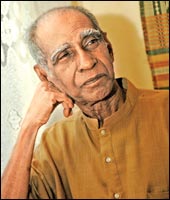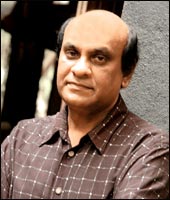Cultural factor in elections
 How
come that so many artistes worked dedicatedly for the President in his
campaign when there were virtually no artistes to bolster the campaign
of the UNP led Opposition? It is indeed strange that the UNP, being the
oldest party and the one that governed this country for a good part
after independence could not find some artistes to stand by the party
while the President’s campaign was backed by a star studded ‘Artistes
brigade’. Reason again is the inherent cultural differences of the two
leaders who spearheads the UPFA and the Opposition campaigns. How
come that so many artistes worked dedicatedly for the President in his
campaign when there were virtually no artistes to bolster the campaign
of the UNP led Opposition? It is indeed strange that the UNP, being the
oldest party and the one that governed this country for a good part
after independence could not find some artistes to stand by the party
while the President’s campaign was backed by a star studded ‘Artistes
brigade’. Reason again is the inherent cultural differences of the two
leaders who spearheads the UPFA and the Opposition campaigns.
President Rajapaksa talks in terms of the need to be patriotic,
gratuitous and Gunagaruka (respect for ethics) which are terms
associated with our culture while Ranil Wickremesinghe talks in terms of
‘democracy’, ‘good governance’ and ‘media freedom’ which are somewhat
abstract to our ethos. National culture is the bread and butter of
artistes and hence they will not find anything in common with leaders
who are culturally disoriented.
Aesthetic faculties
Culture is the harmonious development of all aesthetic faculties of
man; but since men have evolved for centuries in different social groups
such development in aesthetics and values have come to form the identity
and diversity of those different civilizations in their social
evolutions. Hence culture is an ingrained value and behavioural pattern
of social group and that fact makes that group distinct from the rest.
The culture to which a person is born is like a sixth sense to that
person and no matter how superimposing the subsequent adopted lifestyles
he has been through, he would always take to the culture of his birth
like duck to water.
Cultural values
|

W. D. Amaradeva |

Sunil Edirisinghe |

Vasantha Obeysekera |

Senanayake Weralliyadda |
Sri Lankan aesthetics and cultural values came out of hibernation
after independence. But they essentially remained the stock of the
Godaya (vernacular) people for want of patronization by the influential
sections of the society who have by then re rooted themselves in the
Western life styles. But the Godaya people, even though they lacked
influential patronization, always had the strength of their majority and
hence there was always an audience to be entertained by the local
cultural artistes.
However with time, even though nurtured only by the marginalized
locals, the indigenous artistes have developed a unique brand of Sri
Lankan art form during the past 62 years, surviving through the winds of
social upheavals and commercials vicissitudes. They have enriched their
arts borrowing from outside but yet without losing the unique ‘ourness’
of it all.
For instance Amaradeva’s songs are rich in their Eastern musical
chords but they unmistakably have a Sri Lanka character. Hence Sri
Lankan music, dance forms and motion pictures today stand side by side
with the best in the world adding pride to the nation and exemplifying a
role model to the other field of national endowments as well. What is
even more significant is that our aesthetic senses have essentially
resisted pernicious and colonial imbalances that have besotted other
forms of national activity such as commerce and education.
The fact of this cultural permeation is increasingly becoming evident
in the country’s music and dance fields that even those artistes who are
more inclined towards English are compelled to adopt a vernacular
attitude due to the need to obtain majority patronization. Hence even
though those Western inclined artistes find themselves more at home with
their own brand of art they find that it is difficult to make a mark in
Sri Lanka with Western art and music due to lack of demand; and they
cannot make their mark abroad either due to lack of uniqueness. That
reality eventually drives those artistes to sing Sinhala songs even with
an English accent. This is what should be called realistic national
integration in this age because it imparts the richness of Western music
into our traditional bera pada.
However while this cultural evolvement was taking place in the
country, courtesy common man, there was a set of people who had
consigned the local ethos and mores to their servants. Chandrika and
Ranil, though they belong to opposing political parties, belong to that
same class of persons. They belong to the post independent colonial
generation who have not felt the humiliation of being a subject in a
colony but have experience only the good side (the manners, the language
and the elitism) of being a citizen of an ex colony. Ask Ranil
Wickremesinghe who is Sunil Edirisinghe and he will want to know whether
he is an old Royalist: or ask him who is Vasantha Obeysekera and he will
tell you that the Obeysekeras’ are related to Mrs. Bandaranaike. But on
the other hand ask him who is Stevie Wonder or Shirley Bassey then he
probably will fare better. Similarly during Chandrika Bandaranaike’s
regime it was quite evident that she found herself uncomfortable at
official ceremonies when Jayamangala gathas were recited while she made
herself quite at home when carol parties visited her during Christmas.
Cultural President
Mahinda Rajapaksa makes no bones about his goday origins and this is
why Jackson Anthony repeatedly maintained that Mahinda Rajapaksa is the
first cultural President of the country. That is also why Senanayake
Weralliyadda called Mahinda, a colossus who could resuscitate our
indigenousness (Apey kamata pana powana pana athi minisek) in his songs.
Therefore the advent of Mahinda Rajapaksa in to the country’s
leadership, after years of culturally barren leaders was palpably felt
by the artistes in general. In addition President Rajapaksa had that
knack of making local artistes quite at ease with his rustic village
ways.
This was quite a contrast to the other leaders who often took part in
cultural events, not because they wanted to but because they did not
want to offend the majority sensitivities.
A nation cannot be rejuvenated without reinvigorating its cultural
cords because culture is a part of a nation’s self-confidence and its
identity. This lacuna, in the post-independent history of this country,
was felt by the artist and hence they put their hearts and souls to the
campaign to re-elect their cultural representative. |



